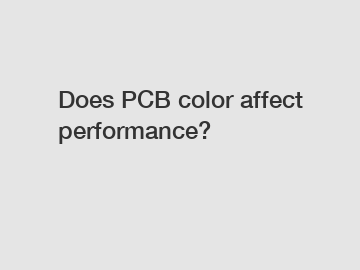Does PCB color affect performance?
Does PCB Color Affect Performance?
Printed Circuit Boards (PCBs) are crucial components in electronic devices, providing the necessary connections and support for various components. PCBs come in different colors, ranging from green to blue, red, and even black. However, a widely debated question is whether the color of the PCB has any impact on its performance. In this article, we will examine the relationship between PCB color and performance, shedding light on this topic of interest to many electronic enthusiasts and professionals.
PCB colors primarily depend on the solder mask applied to the surface of the board. The most popular and widely used color is green, providing an iconic appearance to traditional PCBs. Green solder masks are easily recognizable and have become an industry standard due to their high demand and availability. However, advancements in technology have introduced various other colors, offering a range of choices for PCB designers and manufacturers.

The Role of PCB Color in Performance:
1. Heat Dissipation:
One argument often mentioned is that dark-colored PCBs, such as black or blue, have better heat dissipation properties compared to green PCBs. The darker color can absorb more heat and radiate it away efficiently. However, while the color might influence heat dissipation to some extent, it is important to note that other factors, such as the design and quality of the PCB, thermal vias, and the heat sink, play a more significant role in managing heat.
2. EMI/EMC Considerations:
Electromagnetic Interference (EMI) and Electromagnetic Compatibility (EMC) are crucial factors to consider in electronic devices. Some argue that PCB color can affect EMI/EMC performance. However, the impact of PCB color on EMI/EMC is negligible compared to proper grounding, shielding, and layout techniques. The overall design and adherence to industry standards contribute far more to achieving optimal EMI/EMC performance than the color of the PCB.
3. Aesthetics and Branding:
The color of a PCB can be chosen for aesthetic purposes or to align with the brand image of a company. The color choice might not have a direct impact on the performance of the PCB, but it can be essential for marketing purposes. Coordinating the color of the PCBs with the brand's visual identity can create a consistent and professional look for the final product.
Closing Thoughts:
In conclusion, while PCB color might have some minor influences on factors like heat dissipation and aesthetics, its effect on the overall performance of the circuit board is marginal. The design, quality of components, and adherence to industry standards are far more crucial in determining the performance of the PCB. Therefore, when selecting a PCB color, it is vital to consider factors beyond performance, such as branding and aesthetics.
If you have any further questions or need assistance with PCB design and manufacturing, feel free to contact us. Our team of experts is here to provide you with the guidance and support you need.
For more immersion tin 4layer , immersion tin 4layer , consumer electronics pcb information, please contact us. We will provide professional answers.
176
0
0

Comments
All Comments (0)